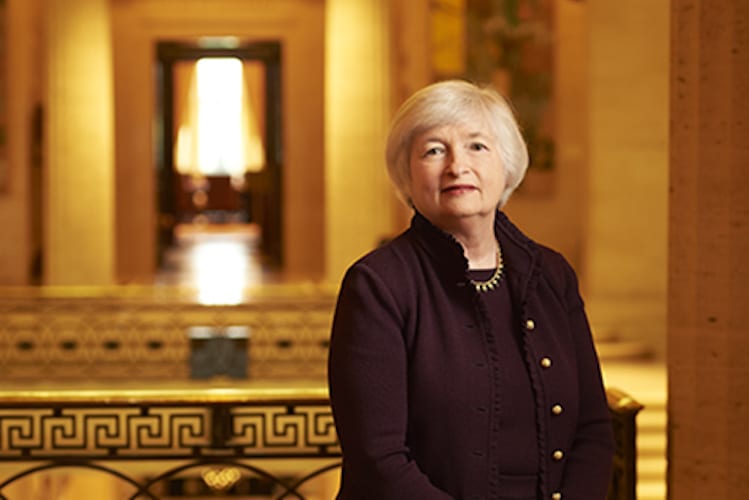
Many Berkeley Haas faculty members have left academia for public service, but arguably none have had a greater impact than Janet Yellen, who retired in early February as the first woman to serve as Federal Reserve chair.
Leadership of the Fed has been called the world’s most powerful economic job. The nation’s central bank makes decisions on interest rates that are critical in determining how fast the economy can grow, how readily jobs are available, and how quickly prices rise. Many economists believe Yellen, Eugene E. and Catherine M. Trefethen Professor Emeritus of Business Administration at Haas, in her four-year tenure, performed the job more effectively than any previous Fed chief.
The Fed has a dual mandate to achieve maximum employment and keep prices in check. Under Yellen’s guiding hand, unemployment fell steadily, from 6.7 percent at the beginning of her term to 4.1 percent when she left. Inflation stayed low even as the economy built up a head of steam. And, to add icing on the cake, financial markets went on a tear, sending stock prices to new levels.
“Yellen is on a glide path to near perfection, as she will probably end her term achieving the Fed’s dual mandate better than any other chair in history,” George Mason University economist Scott Sumner wrote in a blog post in October.
“A brilliant thinker”
Yellen, who earned her economics PhD at Yale, came to Haas in 1980, specializing in macroeconomics and international business. She took leave in 2004 to serve as president of the Federal Reserve Bank of San Francisco, one of 12 regional banks in the Fed system. In 2010, President Obama named her vice chair of the Federal Reserve Board of Governors in Washington, D.C. and promoted her to chair four years later.
Yellen’s colleagues from her years at Haas say they are not surprised by what she accomplished at the Fed. They remember her as a brilliant thinker and teacher who combined rigorous data analysis with a deep understanding of economic theory. “She applied the same methodology as Fed Chair that she used to teach her students,” says Prof. Andrew Rose, the Bernard T. Rocca Jr. Chair in International Business and Trade at Haas. “She’s doing in policy work what she used to do in the classroom.”
Yellen’s legacy goes far beyond a strong economy. Under her predecessor, Ben Bernanke, the Fed launched an extraordinary stimulus program a decade ago to pull the nation out of the great recession. Bernanke’s Fed slashed short-term interest rates close to zero and bought trillions of dollars in U.S. Treasury bonds and other securities to flood the economy with money.
It fell to Yellen to wean the economy from that stimulus. Move too fast and the recovery could sputter. Go too slow and a dangerous bout of inflation could take hold. Yellen chose to keep rates rock bottom far longer than conventional wisdom considered safe, presiding over just small increases in the Fed’s benchmark interest rate. Her genius was to recognize that the rules of the past no longer applied. The evolution of the global economy meant that much lower interest rates could be tolerated without triggering inflation.
A stellar Fed record
As Yellen navigated this delicate course, she had to keep one eye on financial markets. In 2013, under Bernanke, when the Fed first discussed winding down its stimulus program, interest rates spiked, an incident dubbed the “taper tantrum.” To avoid that, Yellen was scrupulous about telegraphing the Fed’s moves well in advance. That strategy succeeded in soothing the financial world. By the time the Fed started selling its hoard of bonds, markets barely reacted.
Yellen has accepted a new position in Washington, D.C., as distinguished fellow at the Brookings Institution’s Hutchins Center on Fiscal and Monetary Policy. Much has been made of the fact that, despite her stellar Fed record, President Trump did not reappoint her when her term ended. Still, his nominee, Jerome Powell, is expected to closely follow the course Yellen set.